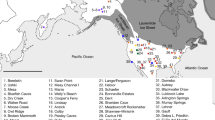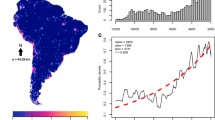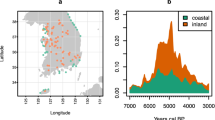Abstract
As the last habitable continent colonized by humans, the site of multiple domestication hotspots, and the location of the largest Pleistocene megafaunal extinction, South America is central to human prehistory1,2,3,4,5,6,7. Yet remarkably little is known about human population dynamics during colonization, subsequent expansions, and domestication2,3,4,5. Here we reconstruct the spatiotemporal patterns of human population growth in South America using a newly aggregated database of 1,147 archaeological sites and 5,464 calibrated radiocarbon dates spanning fourteen thousand to two thousand years ago (ka). We demonstrate that, rather than a steady exponential expansion, the demographic history of South Americans is characterized by two distinct phases. First, humans spread rapidly throughout the continent, but remained at low population sizes for 8,000 years, including a 4,000-year period of ‘boom-and-bust’ oscillations with no net growth. Supplementation of hunting with domesticated crops and animals4,8 had a minimal impact on population carrying capacity. Only with widespread sedentism, beginning ~5 ka4,8, did a second demographic phase begin, with evidence for exponential population growth in cultural hotspots, characteristic of the Neolithic transition worldwide9. The unique extent of humanity’s ability to modify its environment to markedly increase carrying capacity in South America is therefore an unexpectedly recent phenomenon.
This is a preview of subscription content, access via your institution
Access options
Subscribe to this journal
Receive 51 print issues and online access
$199.00 per year
only $3.90 per issue
Buy this article
- Purchase on Springer Link
- Instant access to full article PDF
Prices may be subject to local taxes which are calculated during checkout




Similar content being viewed by others
References
Meltzer, D. J. First Peoples in a New World: Colonizing Ice Age America (Univ. California Press, 2009)
Raghavan, M. et al. Genomic evidence for the Pleistocene and recent population history of Native Americans. Science 349, aab3884 (2015)
Dillehay, T. D. Probing deeper into first American studies. Proc. Natl Acad. Sci. USA 106, 971–978 (2009)
Moore, J. D. A Prehistory of South America: Ancient Cultural Diversity on the Least Known Continent (Univ. Press of Colorado, 2014)
Rothhammer, F. & Dillehay, T. D. The late Pleistocene colonization of South America: an interdisciplinary perspective. Ann. Hum. Genet. 73, 540–549 (2009)
Reich, D. et al. Reconstructing Native American population history. Nature 488, 370–374 (2012)
Barnosky, A. D., Koch, P. L., Feranec, R. S., Wing, S. L. & Shabel, A. B. Assessing the causes of Late Pleistocene extinctions on the continents. Science 306, 70–75 (2004)
Silverman, H. & Isbell, W. Handbook of South American Archaeology (Springer, 2008)
Bocquet-Appel, J. P. & Bar-Yosef, O. (eds) The Neolithic Demographic Transition and its Consequences (Springer, 2008)
Sandweiss, D. H., Solís, R. S., Moseley, M. E., Keefer, D. K. & Ortloff, C. R. Environmental change and economic development in coastal Peru between 5,800 and 3,600 years ago. Proc. Natl Acad. Sci. USA 106, 1359–1363 (2009)
Marquet, P. A., Santoro, C. M., Latorre, C., Standen, V. G. & Abades, S. R. Emergence of social complexity among coastal hunter-gatherers in the Atacama Desert of northern Chile. Proc. Natl Acad. Sci. USA 109, 14754–14760 (2012)
Shennan, S. et al. Regional population collapse followed initial agriculture booms in mid-Holocene Europe. Nature Commun. 4, 2486 (2013)
Rick, J. W. Dates as data: an examination of the Peruvian preceramic radiocarbon record. Am. Antiq. 52, 55–73 (1987)
Williams, A. N. The use of summed radiocarbon probability distributions in archaeology: a review of methods. J. Archaeol. Sci. 39, 578–589 (2012)
Peros, M. C., Munoz, S. E., Gajewski, K. & Viau, A. E. Prehistoric demography of North America inferred from radiocarbon data. J. Archaeol. Sci. 37, 656–664 (2010)
Mellars, P. & French, J. S. Tenfold population increase in Western Europe at the Neandertal-to-modern human transition. Science 333, 623–627 (2011)
Barnosky, A. D. et al. The variable impact of Late-Quaternary megafaunal extinction in causing ecological state shifts in North and South America. Proc. Natl Acad. Sci. USA 113, 856–861 (2016)
Boone, J. L. Subsistence strategies and early human population history: An evolutionary ecological perspective. World Archaeol. 34, 6–25 (2002)
Haub, C. How many people have ever lived on earth? Popul. Today 23, 4–5 (1995)
Keinan, A. & Clark, A. G. Recent explosive human population growth has resulted in an excess of rare genetic variants. Science 336, 740–743 (2012)
Gazave, E. et al. Neutral genomic regions refine models of recent rapid human population growth. Proc. Natl Acad. Sci. USA 111, 757–762 (2014)
Cohen, J. E. How Many People Can The Earth Support? (W.W. Norton & Company, 1995)
Kingsland, S. The refractory model: the logistic curve and the history of population ecology. Q. Rev. Biol. 57, 29–52 (1982)
Sibly, R. M. & Hone, J. Population growth rate and its determinants: an overview. Phil. Trans. R. Soc. B 357, 1153–1170 (2002)
Arim, M., Abades, S. R., Neill, P. E., Lima, M. & Marquet, P. A. Spread dynamics of invasive species. Proc. Natl Acad. Sci. USA 103, 374–378 (2006)
Kelly, R. L., Surovell, T. A., Shuman, B. N. & Smith, G. M. A continuous climatic impact on Holocene human population in the Rocky Mountains. Proc. Natl Acad. Sci. USA 110, 443–447 (2013)
Hassan, F. A. Demographic Archaeology in Studies in Archeology (Academic Press, 1981)
Anderson, D. G., Maasch, K. & Sandweiss, D. H. (eds) Climate Change and Cultural Dynamics: a Global Perspective on Mid-Holocene Transitions (Academic Press, 2011)
Henrich, J. Demography and cultural evolution: how adaptive cultural processes can produce maladaptive losses: the Tasmanian case. Am. Antiq. 69, 197–214 (2004)
Pinhasi, R., Fort, J. & Ammerman, A. J. Tracing the origin and spread of agriculture in Europe. PLoS Biol. 3, e410 (2005)
Ramsey, C. B. Bayesian analysis of radiocarbon dates. Radiocarbon 51, 337–360 (2009)
Hogg, A. G. et al. SHCal13 Southern Hemisphere calibration, 0–50,000 years cal bp. Radiocarbon 55, 1889–1903 (2013)
Reimer, P. J. et al. IntCal13 and Marine13 radiocarbon age calibration curves 0–50,000 years cal bp. Radiocarbon 55, 1869–1887 (2013)
Gayo, E. M., Latorre, C. & Santoro, C. M. Timing of occupation and regional settlement patterns revealed by time-series analyses of an archaeological radiocarbon database for the South-Central Andes (16°–25° S). Quat. Int. 356, 4–14 (2015)
Thompson, L. G. et al. A 25,000 year tropical climate history from Bolivian ice cores. Science 282, 1858–1864 (1998)
Petit, J. R. et al. Climate and atmospheric history of the past 420,000 years from the Vostok ice core, Antarctica. Nature 399, 429–436 (1999)
ArcGIS Version 10 (Redlands CA: Environmental Systems Research Institute Inc., 2010)
Silverman, B. W. Density Estimation for Statistics and Data Analysis (Chapman & Hall, London, 1986)
Epanechnikov, V. A. Non-parametric estimation of a multivariate probability density. Theory Probab. Appl. 14, 153–158 (1969)
Wand, M. P. & Jones, M. C. Kernel Smoothing (Crc Press, 1994)
Chaput, M. A. et al. Spatiotemporal distribution of Holocene populations in North America. Proc. Natl Acad. Sci. USA 112, 12127–12132 (2015)
Brown, W. A. Through a filter, darkly: population size estimation, systematic error, and random error in radiocarbon-supported demographic temporal frequency analysis. J. Archaeol. Sci. 53, 133–147 (2015)
Hinz, M., Feeser, I., Sjögren, K. G. & Müller, J. Demography and the intensity of cultural activities: an evaluation of Funnel Beaker Societies (4200–2800 cal bc). J. Archaeol. Sci. 39, 3331–3340 (2012)
Downey, S. S., Bocaege, E., Keri, T. E., Edinborough, K. & Shennan, S. The Neolithic demographic transition in Europe: correlation with juvenility index supports interpretation of the summed calibrated radiocarbon date probability distribution (SCDPD) as a valid demographic proxy. PLoS ONE 9, e105730 (2014)
Woodbridge, J. et al. The impact of the Neolithic agricultural transition in Britain: a comparison of pollen-based land-cover and archaeological 14C date-inferred population change. J. Archaeol. Sci. 51, 216–224 (2014)
Contreras, D. A. & Meadows, J. Summed radiocarbon calibrations as a population proxy: a critical evaluation using a realistic simulation approach. J. Archaeol. Sci. 52, 591–608 (2014)
Michczynska, D. & Pazdur, A. Shape analysis of cumulative probability density function of radiocarbon dates set in the study of climate change in the Late Glacial and Holocene. Radiocarbon 46, 733–744 (2004)
Michczynska, D. J., Michczynska, A. & Pazdur, A. Frequency distribution of radiocarbon dates as a tool for reconstructing environmental changes. Radiocarbon 49, 799–806 (2007)
Surovell, T. A., Finley, J. B., Smith, G. M., Brantingham, P. J. & Kelly, R. Correcting temporal frequency distributions for taphonomic bias. J. Archaeol. Sci. 36, 1715–1724 (2009)
Reimer, P. J. et al. IntCal13 and Marine13 radiocarbon age calibration curves 0–50,000 years cal bp. Radiocarbon 55, 1869–1887 (2013)
Ogburn D. E. Reconceiving the chronology of Inca imperial expansion. Radiocarbon 54, 219–237 (2012)
Seidel, D. J., Fu, Q., Randel, W. J. & Reichler, T. J. Widening of the tropical belt in a changing climate. Nature Geosci. 1, 21–24 (2008)
MATLAB Release 2015a (The MathWorks, Natick, Massachusetts, USA)
Schwarz, G. E. Estimating the dimension of a model. Ann. Stat. 6, 461–464 (1978)
Acknowledgements
We thank A. Barnosky, J. Kang, N. Rosenberg, E. Lindsey, N. Villavicencio, L. Frishkoff, K. Solari, J. Hsu, and H. Frank for conversations and feedback on the paper, as well as E. Jewett and M. Edge for discussions of statistical methods. We also greatly appreciate assistance from the Stanford Geospatial Center. This work was stimulated by discussions of an NSF-funded group (EAR 1148181) comparing the timing of megafaunal extinctions with archeological and palaeoenvironmental data in South America. We acknowledge support from NSF grant BCS 1515127, as well as NSF Graduate Research and ARCS fellowships to A.G., a Stanford Interdisciplinary Graduate Fellowship to A.M.M, and a Gabilan Fellowship to E.A.H. Radiocarbon data and associated information are available in the Supplementary Information.
Author information
Authors and Affiliations
Contributions
A.G. conducted analyses and wrote the first draft of the paper. A.M.M. collected and collated the database, and conducted ArcGIS analyses. E.A.H. advised the analyses and initiated the project. All authors interpreted results, and contributed to framing and editing of the paper.
Corresponding author
Ethics declarations
Competing interests
The authors declare no competing financial interests.
Extended data figures and tables
Extended Data Figure 1 Kernel Density estimates of occupied area for alternative time bins.
Estimates of occupied area in 1,000-year time bins for dates not present in Fig. 2, considering uniquely occupied sites in each time bin.
Extended Data Figure 2 Kernel Density estimates of occupied area for fixed search radius.
Estimates of occupied area in 1,000-year time bins for dates present in Fig. 2, using a fixed radius for all time slices of 660 km.
Extended Data Figure 3 Statistical evaluation of constant population size in the mid-Holocene.
The simulated 98% confidence interval (grey) for radiocarbon density under a constant population size in 5-year bins, with the observed SCPD for the data (black).
Extended Data Figure 4 Observed oscillations are outside the variation of simulated constant size.
A histogram of the variance of 200 simulated constant size SCPDs, with the observed variance of density in the observed SCPD from 9 to 5.5 ka outside the distribution of those simulated.
Extended Data Figure 5 Inferred population size over time.
Assuming colonization of South America 14.8 ka by a population of size N0, we plot the relative increase in population size over time under the two-phase model (black). Carrying capacity (grey) occurs approximately 8.5 ka with a relative population size N/N0 = 274.6, and a final population size at 2 ka of N/N0 = 616.6.
Extended Data Figure 6 SCPD for Andean/Pacific Coastal Region.
The Pacific Coast region and Andes, which represents 52% of dates and multiple of the major cultural centres, show a similar trend as the SCPD for the continent.
Supplementary information
Supplementary Data
This file contains Supplementary Dataset 1. (XLSX 471 kb)
Rights and permissions
About this article
Cite this article
Goldberg, A., Mychajliw, A. & Hadly, E. Post-invasion demography of prehistoric humans in South America. Nature 532, 232–235 (2016). https://doi.org/10.1038/nature17176
Received:
Accepted:
Published:
Issue Date:
DOI: https://doi.org/10.1038/nature17176
This article is cited by
-
Reconstructing colonization dynamics to establish how human activities transformed island biodiversity
Scientific Reports (2024)
-
The role of farming and fishing in the rise of social complexity in the Central Andes: a stable isotope perspective
Scientific Reports (2024)
-
Landscape Taphonomy Predictably Complicates Demographic Reconstruction
Journal of Archaeological Method and Theory (2023)
-
From the Ground Up: A Multidisciplinary Approach to Past Fertility and Population Narratives
Human Nature (2023)
-
Climate and demography drive 7000 years of dietary change in the Central Andes
Scientific Reports (2022)
Comments
By submitting a comment you agree to abide by our Terms and Community Guidelines. If you find something abusive or that does not comply with our terms or guidelines please flag it as inappropriate.



